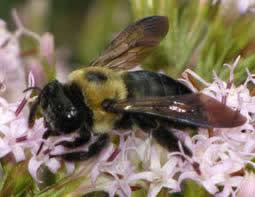CT Carpenter Bees and the Damage they Cause
 CT Carpenter Bees and the Damage they Cause. Carpenter bees nest in unfinished wood causing damage to both structure and appearance. Though each nest may only extend 6 to 12 inches, multiple bees may work in the same area and expand on old nest tunneling systems.
CT Carpenter Bees and the Damage they Cause. Carpenter bees nest in unfinished wood causing damage to both structure and appearance. Though each nest may only extend 6 to 12 inches, multiple bees may work in the same area and expand on old nest tunneling systems.
Over time these hollow spaces may encourage water damage, reduce structural integrity, and in some cases attract wood peckers. Once enough damage has been sustained, costly repairs must be made. Carpenter bees are found throughout Connecticut. They resemble bumble bees, with less hair on the abdomen.
The carpenter bee we find in CT is known as Xylocopa virginica virginica. Both males and females are large and black, marked with areas of yellow hair. Compared to bumble bees, carpenter bees are almost bald, exhibiting a metallic shine, males have a yellow spot located on the head between the large, clearly visible eyes.
In the springtime, adults carpenter bees emerge from their winter slumber in search of nectar. Food is needed as mating takes place and nest building begins again. Nesting may take place in existing nest galleries, extensions of existing galleries, or new chambers in a new location.
Suitable locations quickly become filled with entrance holes, that look like drilled holes, from multiple bees working independently. Old rotten tree limbs in nature provide natural locations for nesting, while trim boards, siding, fences, poles, posts, beams, soffits, doors, picnic tables, swing sets etc. provide ideal nesting conditions for carpenter bees.
Entrance holes mark carpenter bee activity and may increase in numbers over time. New galleries may only be 3 to 4 inches in length, but many bees working together may construct chambers 3 to 6 feet long. Males collect pollen and nectar while females, the only sex with a stinger, do most of the excavation.
In Spring, the strong and aggressive males carpenter bees in CT will attack and try to either defend their nesting territory or mate with any insects flying around. Inquisitive males may fly quite close to humans as well, but they cannot sting. Waving a hand around is usually sufficient to scare them off if necessary. Females do have a stinger but they tend to be in the nest, and only sting when handled.
Carpenter bees can be safely controlled with direct pesticide applications, but that may not solve the problem. Replacing bare wood with composite or plastic trim will resolve the issue permanently. Exposed wood should be coated with some permanent finish such as paint of stain. Prevention of access to untreated surfaces is also important. Gaps in vents, gable, louvers etc. may let carpenter bees into areas that are ideal for nesting, sawdust falling out all over the patio in a good indication you have carpenter bees nesting somewhere in or near your house!
The first step towards resolving carpenter bee infestations is getting professinal help from a CT Pest Control Specialist.
Call us today 888-558-1574.


